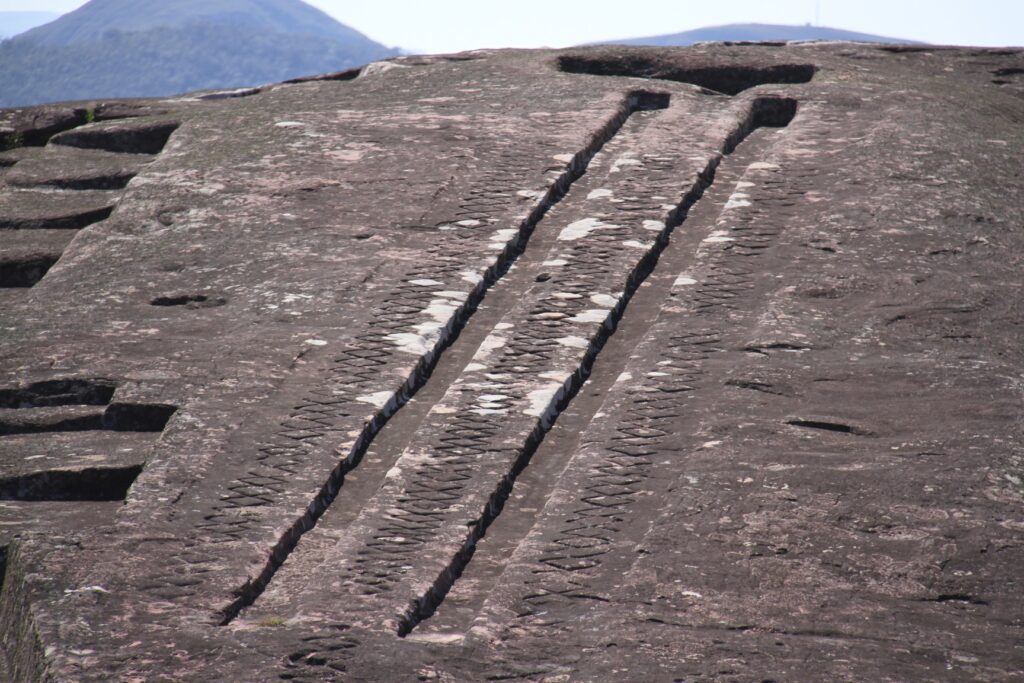Introduction to Samaipata
Samaipata, located in the foothills of the Andes in Bolivia, is one of South America’s most remarkable archaeological treasures. Known for its massive sandstone formation, referred to as the “Fortaleza,” Samaipata is a megalithic site adorned with intricate petroglyphs. These carvings, combined with its strategic location and historical significance, make it a subject of fascination for archaeologists, historians, and travelers alike.
The Fortaleza – A Canvas of Ancient Artistry
Intricate Petroglyphs
The centerpiece of Samaipata is the Fortaleza, a colossal sandstone slab etched with extensive petroglyphs. These carvings feature geometric patterns, animal figures, and abstract symbols. The precision and scale of these designs are testaments to the advanced craftsmanship and vision of its creators.
- Interpretation: Scholars hypothesize that these petroglyphs held spiritual or symbolic significance, possibly representing myths, rituals, or cosmological beliefs.
- Complexity: Unlike simple rock art, the carvings are deeply intricate, indicating a sophisticated understanding of both tools and artistry.
Platforms, Terraces, and Channels
In addition to the carvings, the Fortaleza features a series of platforms, terraces, and drainage canals. These elements hint at a functional aspect, suggesting that the site may have been used for ceremonial gatherings or as an observatory. The architectural layout aligns with the Andean tradition of integrating structures with natural landscapes.

Historical and Cultural Significance
A Center for Ceremonial and Astronomical Activities
While the exact purpose of Samaipata remains uncertain, many researchers believe it served as both a ceremonial and astronomical site.
- Ceremonial Role: The site’s orientation and features suggest it may have been used for religious rituals or communal events, likely involving offerings to deities.
- Astronomical Function: The carvings and structures may align with celestial events, such as solstices or equinoxes, reflecting a deep understanding of astronomy by its creators.
Connection to Pre-Inca and Inca Civilizations
Archaeological evidence places Samaipata within the cultural sphere of pre-Inca and Inca civilizations. The site likely functioned as a hub for trade, cultural exchange, and administration due to its position on trade routes linking the Andes and Amazon. The blend of Andean and Amazonian influences observed in the site’s design and iconography highlights the diversity of its cultural connections.

UNESCO Recognition and Ongoing Research
A UNESCO World Heritage Site
In 1998, Samaipata was designated a UNESCO World Heritage Site, cementing its status as a cultural and historical landmark. The site is celebrated for its extraordinary blend of art, science, and architecture, reflecting the ingenuity and spirituality of its ancient builders.
Current Excavations and Studies
Ongoing excavations and research continue to uncover details about the civilization that created Samaipata.
- Potential Discoveries: These efforts aim to decode the meaning behind the petroglyphs and unveil more about the social and religious practices of its people.
- Global Relevance: As more is learned, Samaipata contributes to the broader understanding of pre-Columbian cultures in South America, enriching global history.

Mysteries Yet to Be Solved
Despite extensive studies, many questions about Samaipata remain unanswered:
- What specific rituals or ceremonies were performed here?
- What do the intricate symbols and patterns truly signify?
- How did its builders achieve such precision in their carvings without modern tools?
These mysteries continue to inspire curiosity and draw researchers and tourists to Samaipata, ensuring its legacy as one of Bolivia’s most enigmatic landmarks.

Conclusion
Samaipata stands as a testament to the ingenuity, artistry, and spiritual depth of its ancient creators. From its intricate carvings to its architectural marvels, the site offers a glimpse into a sophisticated civilization that once thrived in the region. As studies progress, Samaipata holds the promise of revealing even more secrets about the cultures of pre-Columbian South America, enriching our understanding of human history.
